HISTORY 135F
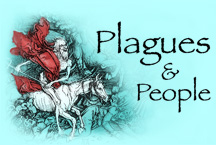
Infectious and
Epidemic Disease in History
Department of History
University of California, Irvine
Instructor: Dr. Barbara J. Becker
HISTORY 135F

Infectious and
Epidemic Disease in History
Department of History
University of California, Irvine
Instructor: Dr. Barbara J. Becker
Improvements in the design of ships and sails, the introduction of the boxed compass and other navigational aids enabled sailors to undertake longer sea voyages. Silver, much of it mined in the Harz Mountains of Saxony, provided the financial resources to equip major expeditions in search of new territory, new subjects for slaves, spices and treasure. When, at the turn of the 16th c, Europeans discovered and explored what was -- for them -- a New World, individuals from drastically different "disease pools" were brought into close contact with deadly consequences for both populations.
Map showing Columbus's view of distance between the Azores and Japan. Christopher Columbus's (1451-1506) confidence in the probable success of his plan to sail to the Far East was based on two errors. First, he relied on a figure for the size of the earth, which -- although correct by modern standards -- was expressed in Arabic units. Columbus mistakenly thought these units were equivalent to Roman miles. This mistake (like confusing miles for kilometers) caused him to underestimate the size of the earth by about 75%. Second, he greatly overestimated the overland distance to the easternmost ports in Asia. |
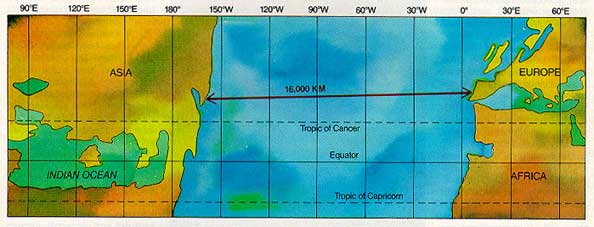
Map of the world (c. 150 CE) according to Claudius Ptolemy of Alexandria (fl. 125 CE). Ptolemy's estimate of the size of the earth is consistent with modern measures, but reports he had gathered from individuals who had traveled to the Far East led him to overestimate the size of the Euro-Asian land mass. |
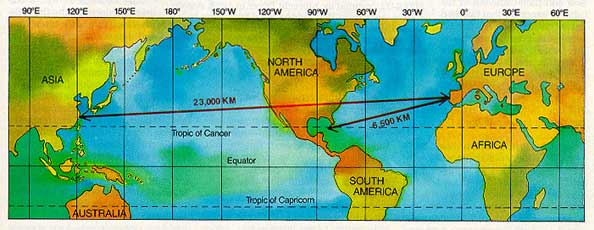
Modern map of the world. The American land mass is located roughly where Columbus anticipated finding Asia. After Columbus's initial voyage, maps of the world changed rapidly. As nations vied for territory, officials cloaked the new maps in the highest secrecy making it a capital crime to divulge the information they contained. The "Cantino" map (1502; shown below) is one such secret document. Named for the Italian diplomat, Alberto Cantino, who smuggled it out of Portugal, it is the first map of its kind that can be dated with certainty. The vertical line that divides the map marks the meridian set by the Treaty of Tordesillas (1494) which separated the New World into territory that could be claimed by Spain (all new lands west of the line) and Portugal (new lands to the east). Although most known land areas are identified, the cartographer included one unnamed mystery land at the map's upper left edge. Is it Florida? It's possible, but Florida was not officially "discovered" until Ponce de Leon claimed it in 1513. It could simply be the cartographer's attempt to situate the new discoveries with respect to the Asian mainland. |
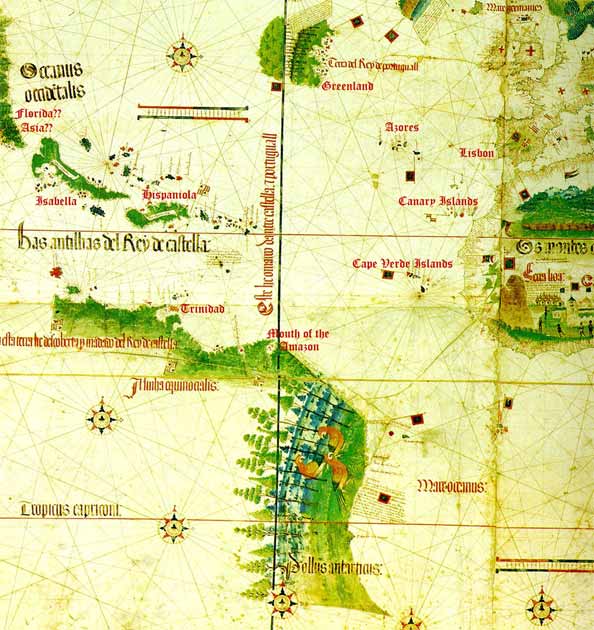
Cantino Map (1502)
_____________

Map of the world (1505) sketched by Christopher Columbus's
brother, Bartolommeo (1460-1514). Note the presumed connection (in the lower
left corner) of "Mondo Novo" (South America) with the Asian mainland.
|
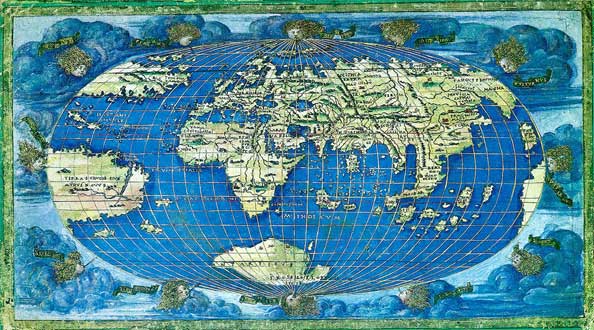
World Map (c. 1508) by Francesco Rosselli (c. 1445-1513). Roselli's map shows new details based on exploration of the Amazon, but he leaves the question of a connection between Asia and the rest of the New World ambiguously unanswered at the map's edges. |
Contact: Spaniards and the Mexica |
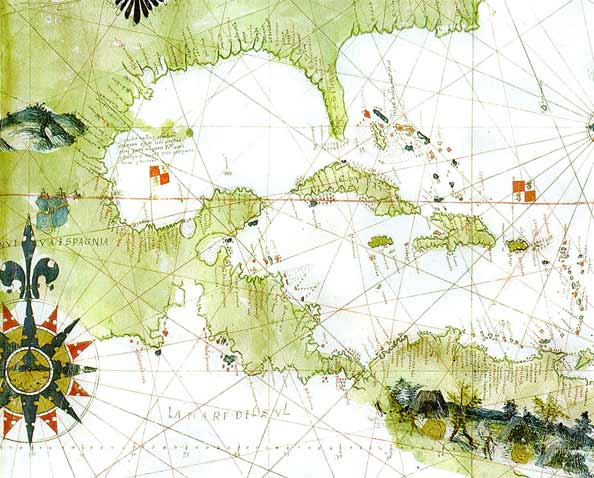
The New World (1526) by Juan Vespucci (fl. 1512-1526), nephew of Amerigo Vespucci (1454-1512). Note Lake Texcoco and the island city of Tenochtitlán (the blue area located above and to the right of the compass rose). |
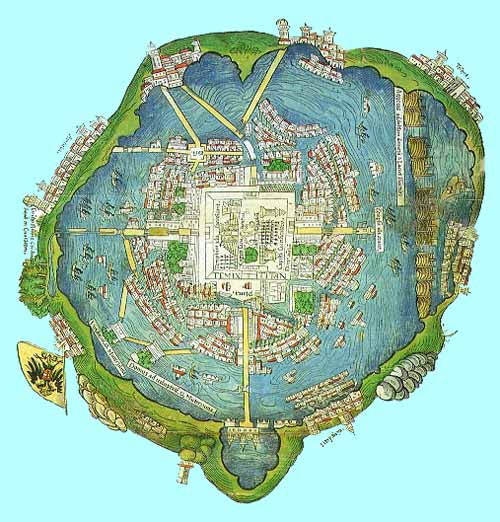
The island city of Tenochtitlán (1524) by Hernando Cortes (1485-1547). Population in 1517: about 200,000. |
| · creation of the world | |
| · rise of Olmecs | |
| · writing developed | |
| · empire of Teotihuacán | |
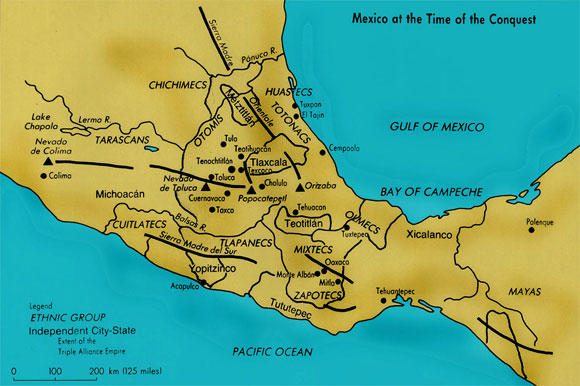 |
|
| · decline of Olmecs | |
| · unknown event destroys civilization at Teotihuacán | |
| · classic period of Maya ends | |
| · Toltecs | |
| · nomadic tribe of the Nahua people settle on island in Lake Texcoco
(Tenochtitlán)
· call themselves the Mexica |
|
| · Mexica form alliance with neighboring Texcoco and Tacuba | |
| · devastating famine | |
| · Triple Alliance extends control over basin to Gulf of Mexico | |
| · Alliance influence extends to Pacific Ocean at Acapulco | |
| · Spanish arrive on the shores of Yucatán under Hernández de Córdoba | |
Bad omens warned the Mexica of coming disasters: The first bad omen: Ten years before the Spaniards first came here, a bad omen appeared in the sky. It was like a flaming ear of corn, or a fiery signal, or the blaze of daybreak; it seemed to bleed fire, drop by drop, like a wound in the sky. It was wide at the base and narrow at the peak, and it shone in the very heart of the heavens.... |
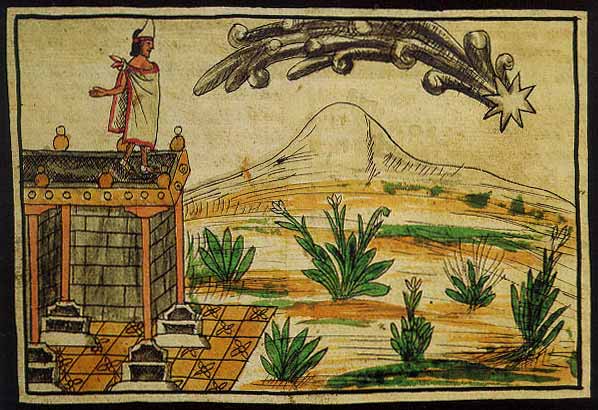
Moctezuma views a comet.
|
The second bad omen: The temple of Huitzilopochtli burst into flames.... The third bad omen: A temple was damaged by a lightning-bolt.... The fourth bad omen: Fire streamed through the sky while the sun was still shining.... The fifth bad omen: The wind lashed the water until it boiled. ... The sixth bad omen: The people heard a weeping woman night after night.... The seventh bad omen: The men whose work is in the Lake of Mexico trapped a dark-feathered bird resembling a crane and took it to Moctezuma so that he might see it.... This bird was so unique and marvelous that no one could exaggerate its strangeness or describe it well. A round diadem was set in its head in the form of a clear and transparent mirror, in which could be seen the heavens, the three stars in Taurus and the stars in the sign of the Gemini. When Moctezuma saw this, he was filled with dread and wonder, for he believed it was a bad omen to see the stars of heaven in the diadem of that bird. When Moctezuma looked into the mirror a second time, he saw a host of people, all armed like warriors, coming forward in well-ordered ranks. They skirmished and fought with each other, and were accompanied by strange deer and other creatures.... The eighth bad omen: Monstrous beings appeared in the streets of the city.... |
| · Hernando Cortes begins exploring the Yucatán | |
| · Cortes meets the Mexica leader, Moctezuma | |
| · Tenochtitlán falls to the Spanish |
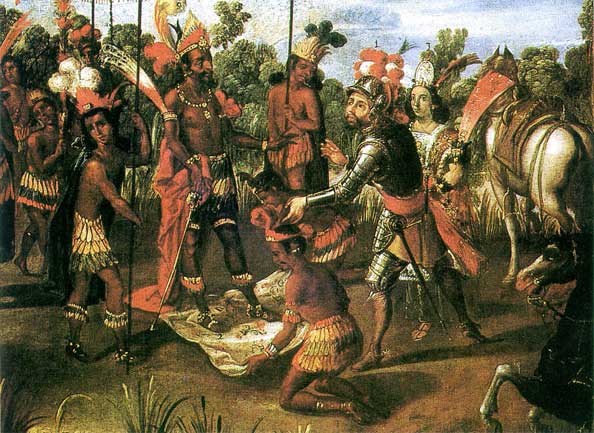
| 1523 | · Church authorizes Franciscan monks to go to New Spain
· Franciscans believe the Mexica to be the lost tribes of Israel
· converting the Mexica to Christianity will bring about the millennium |
| 1529 | · Fray Bernardino de Sahagún (1499-1590) arrives |
| 1536 | · Dominicans arrive in New Spain |
| 1558 | · Church becomes disenchanted with lack of success of missionary efforts
· Church orders Sahagún to develop:
· information gathered will enable Spanish to restore the Mexica to their pre-conquest splendor based on Christianity |
| 1570 | · Church establishes Inquisition in Mexico |
Native Aztec Medicine |
|||||||||
Presumed causes of disease dictate recommended cures--
Individual illness is generally the result of a complex of causes-- Respiratory problems, for example, can result from a mix of any or all of the following:
Three animistic forces are associated with the body and connected to cosmos: |
|
|
|
|
|
|
|
|
|
|
|
|
|
|
an omen established at birth--a particular tendency
and temperament that determines the future life of an individual
it is a link to the gods and heavens collectively, not to any one particular planet or star can be lost during certain activities like sexual intercourse, or dreaming, or trances individuals must take care not to lose tonalli unexpectedly twins share one tonalli and are therefore considered "cold"--capable of sucking heat from other things fetus of pregnant mother will suck tonalli from nursing toddler |
|
|
|
|
gives an individual his/her vitality, knowledge,
vocational ability
it resides in the heart which is the center of thought and personality it is what "goes beyond after death"--the stuff of the dead spirits teyolia of warriors--accompany the sun while the warriors are reincarnated as hummingbirds teyolia of women who die in childbirth--accompany the sun from noon to sunset while the women become cihuateteo--beings able to return to earth on certain days to afflict humans who chance to meet them; teyolia of sacrificed humans--become the sacrificial gods' servants teyolia of those chosen by Tlaloc (drowning victims), for example--live in mountain caves and assist the god Tlaloc and his followers in sending rain; produce diseases associated with Tlaloc |
|
|
|
|
breath, respiration
gives vigor, passions, feelings like desire, envy, and anger it is a luminous gas with the property of attracting other beings magnetic stones are said to attract things with iyihotl |
Contact: English and Wiroans |
|
|
Organized three major expeditions to the New World:
|
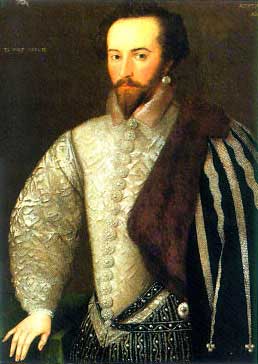 |
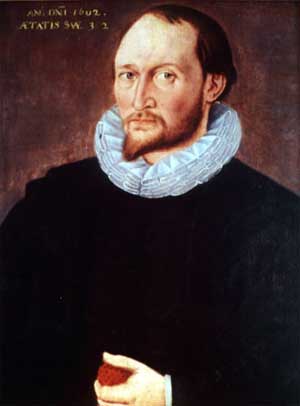 |
|
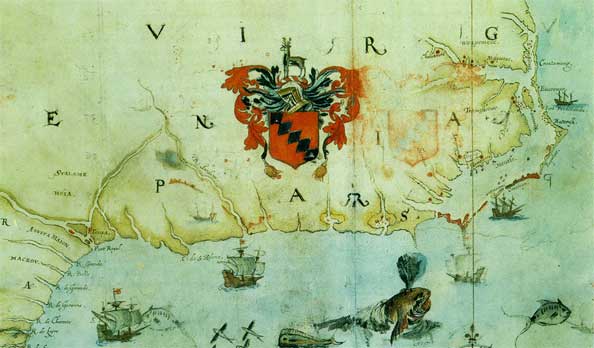
Map of "Virginia", home of the Wiroans, by Captain John
White (1585). White's map shows only a portion of the extensive land allocated to the original Virginia Colony. Ironically, the map does not include any of modern day Virginia (the border of which is located just beyond the top of the map). The coastline seen here is largely that of modern day North Carolina. Note the fine representation of the Outer Banks. The lower left depicts the northernmost region of what is now South Carolina.
|
 |
| Go to: |
|
|